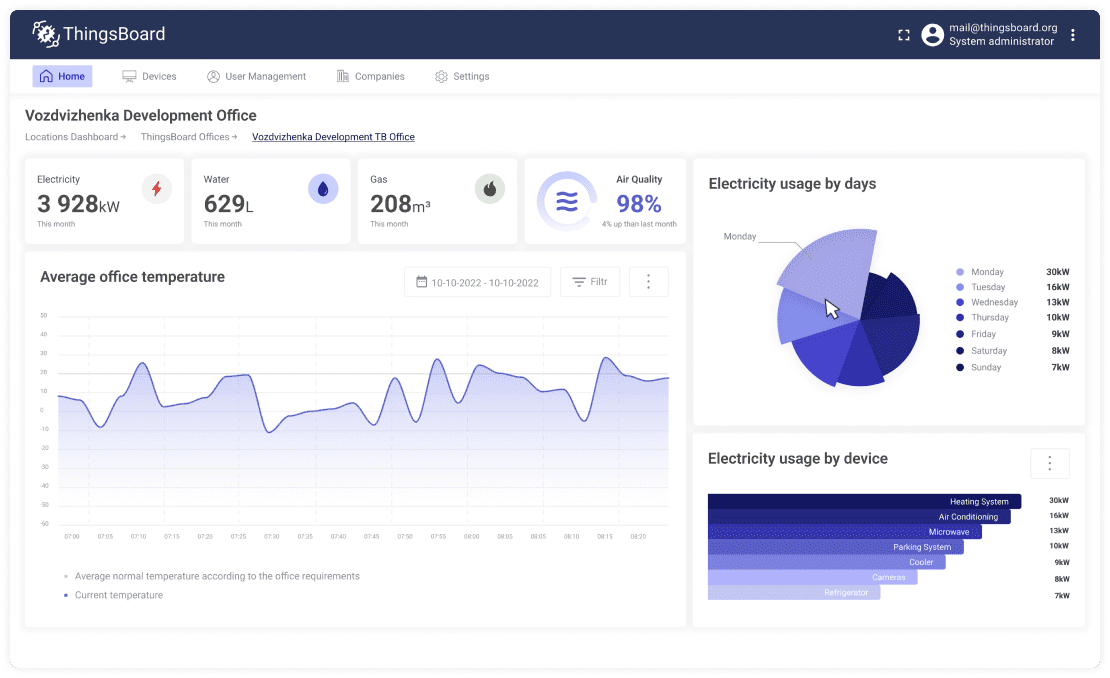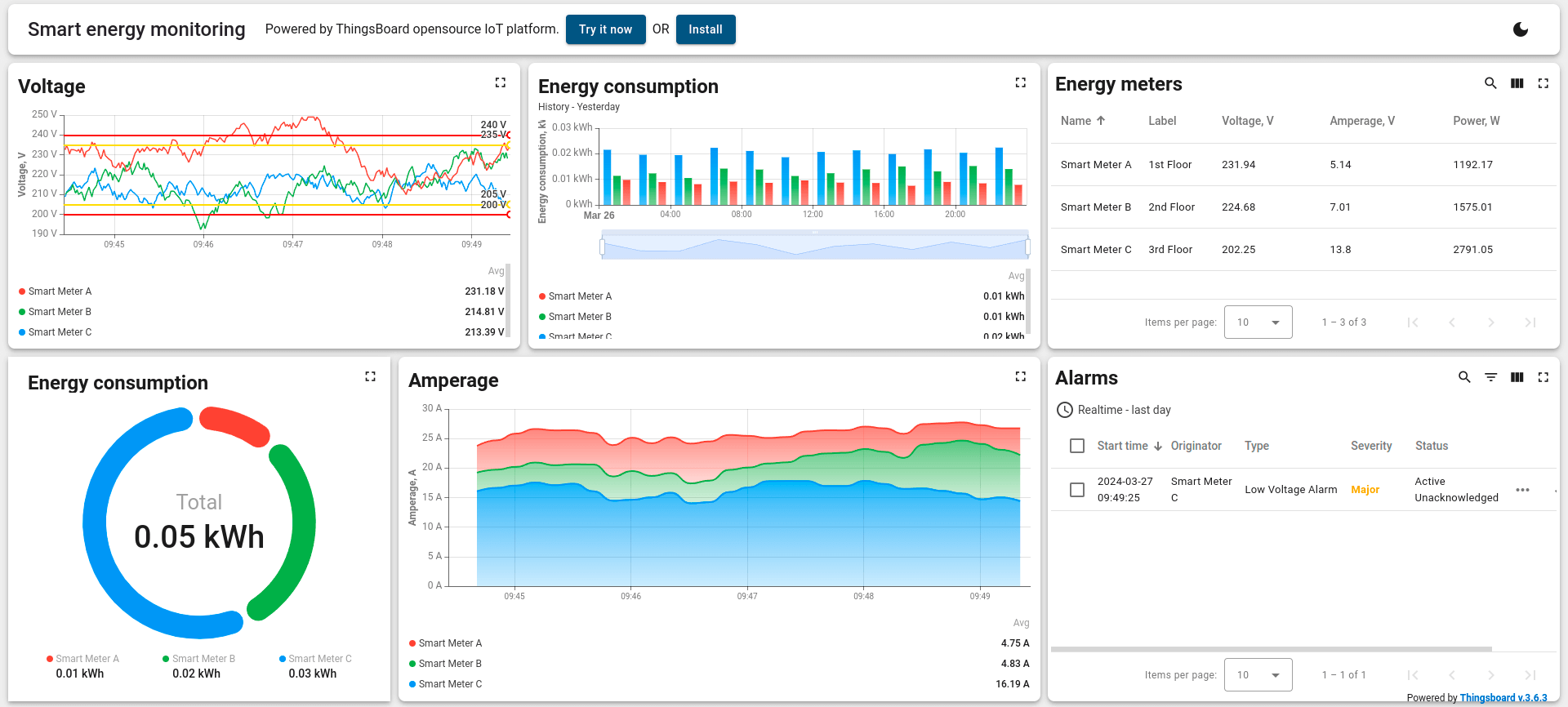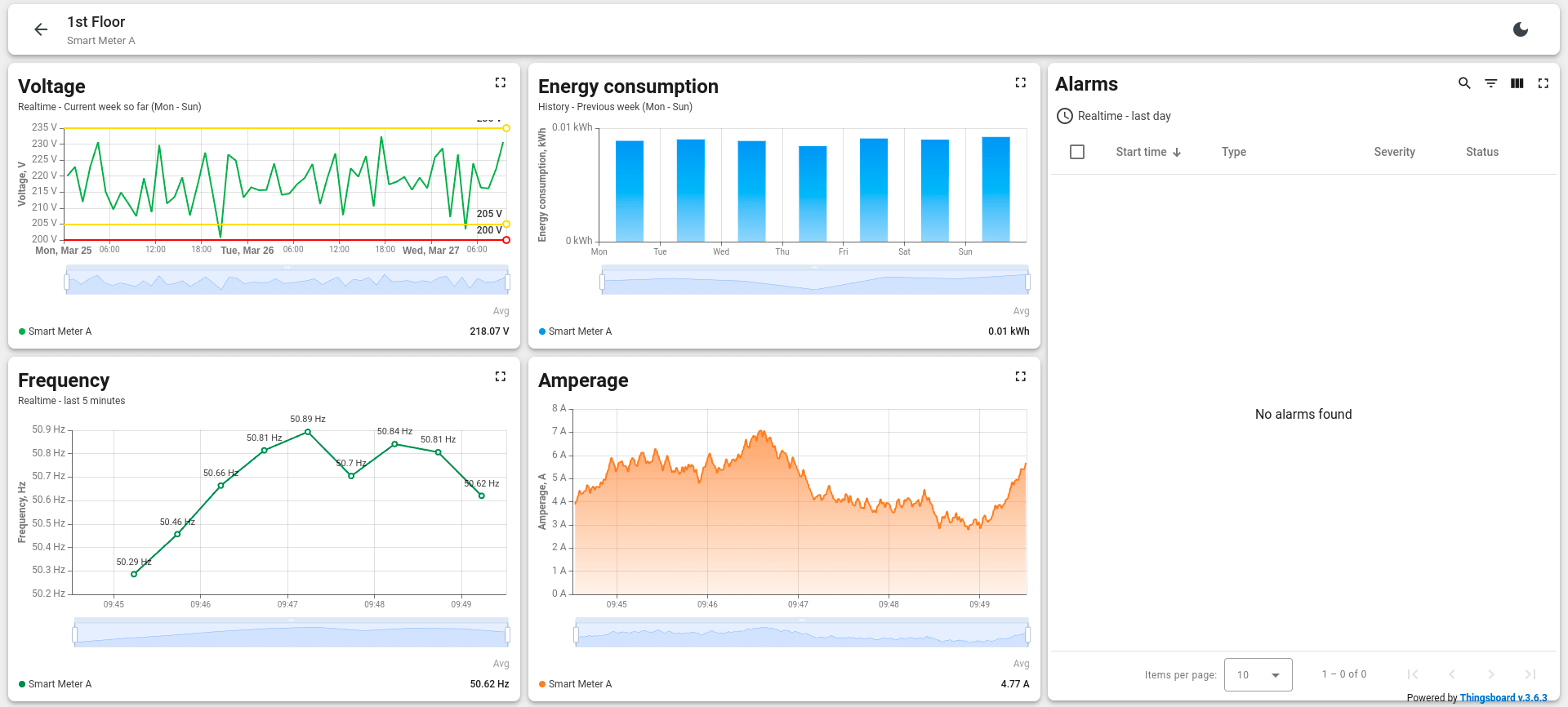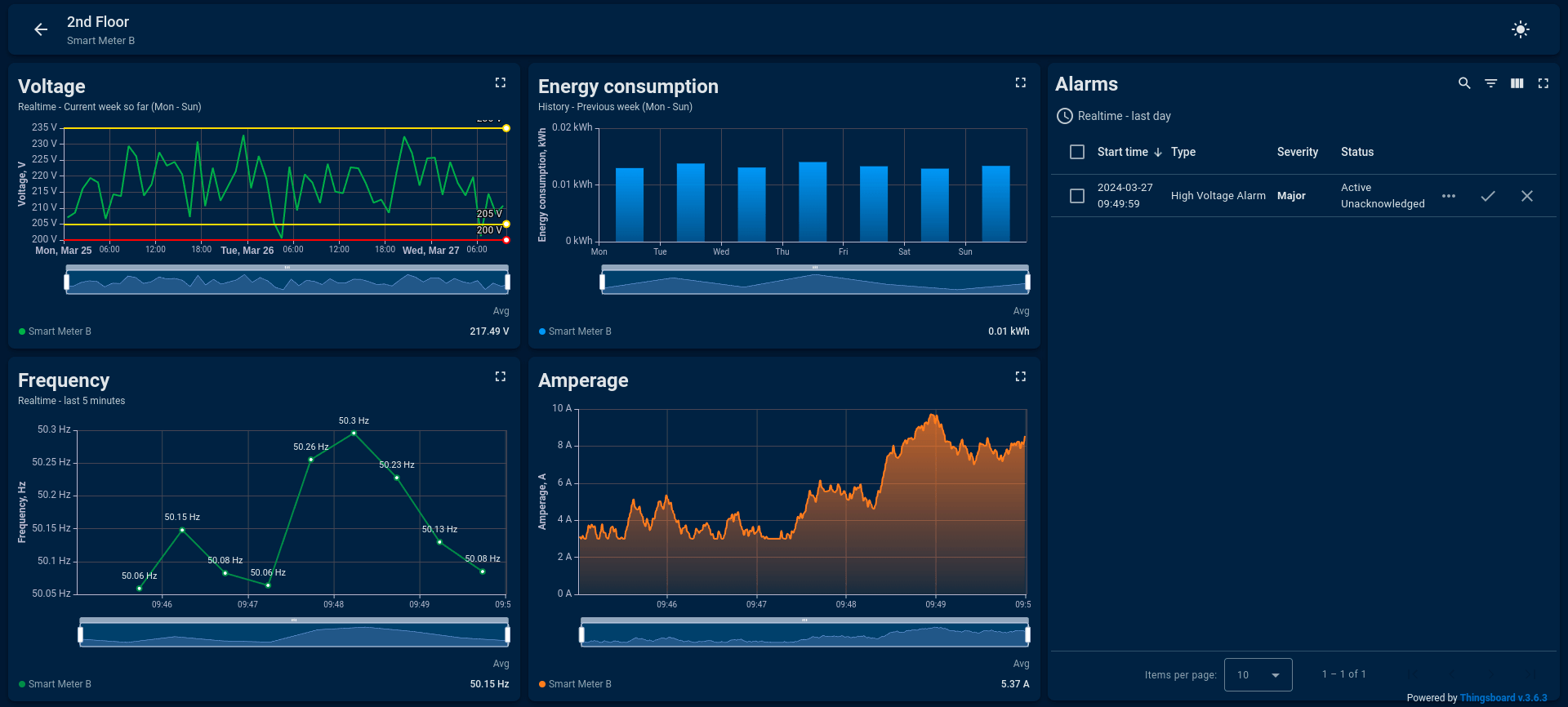IoT Energy Management
Energy in business is a crucial resource that influences workflows. It is also an essential component of every business strategy that leads to business scaling and growth. Companies across the globe are adopting smart energy management systems to increase sustainability.
In an era where sustainability and efficiency are not just buzzwords, the role of the Internet of Things (IoT) in energy management and monitoring cannot be overstated. Harnessing the power of IoT for energy monitoring leads to significant cost savings, improved operational efficiency, and a reduced environmental footprint.
ThingsBoard platform dramatically reduces time to market and efforts to create smart-energy solutions. Save up to 90% of development time for your smart-energy solution by utilizing the following platform benefits:
- Reliable and scalable data collection for your smart meters and energy monitors;
- Powerful rule engine to process collected data and produce alarms and valuable insights;
- Advanced and flexible visualization for real-time and historical data;
- Customizable end-user dashboards to analyze and share the results of energy efficiency monitoring;
- Integration with third-party analytics frameworks and solutions for advanced electricity usage analytics;
- Remote control and OTA updates for your smart meters and other devices;
- Customizable mobile applications with minimum coding efforts;

How Does It Work?
IoT energy management is the process that includes data collection, data transmission, data analysis, remote control, and automation.
The measurement data relevant to this is partly collected manually from distributed data sources and imported, e.g., via CSV files, into energy data collection systems. The analysis and evaluation are often carried out via self-created MS Excel sheets, from which the necessary diagrams are subsequently created.
The IoT revolutionizes this process. IoT energy monitoring system works by connecting devices and appliances to the Internet and collecting real-time data on their energy usage. This data is then processed and analyzed to provide valuable insights into energy consumption patterns.
IoT-based energy management systems use real-time power consumption data to help optimize the use of electricity, and dynamically switch towards more cost and resource-efficient regimes.
IoT sensors collect data on the consumption of electricity, water, heat, etc., measure pressure, temperature, and others to control the status of assets, as well as detect leakages. Actuators connected to the sensors automatically shut off and resume the supply of gas, water, heat, and so on.
IoT energy management software automates the manual processes that require a significant number of man-hours. Time-consuming jobs such as meter readings and power generation/distribution are handled by the system, eliminating the need for manual work and ensuring accurate, real-time readings.
Advantages of Using IoT Energy Management
The implementation of smart energy management using IoT comes with a multitude of advantages. Here are some key benefits:
- Identifying and mitigating potential failures: Smart energy monitoring systems using IoT can detect unusual behavior and patterns that could indicate potential failures, helping to reduce risk.
- Optimizing energy consumption and occupant comfort: IoT power monitors can automatically adjust energy consumption based on factors such as economic and commercial factors, time of day, and weather conditions.
- Centralizing monitoring and control: Energy IoT platform provides centralized monitoring and control of energy consumption across multiple facilities.
- Improving energy efficiency: IoT helps businesses improve their energy efficiency by providing insights into their energy consumption patterns and identifying areas where savings can be achieved. For example, IoT systems can be used to track the energy consumption of individual devices or equipment and to identify devices that are consuming more energy than necessary.
- Improved Sustainability: The integration of IoT-based smart energy monitoring reduces maintenance and operating costs, leading to ongoing savings.
- Ensuring regulatory compliance: IoT in energy management can ensure regulatory compliance, making it easier for companies to adhere to energy regulations.
- Reduced operational expenses: By improving energy efficiency and reducing energy waste, businesses can reduce their overall energy consumption. This can lead to significant savings on energy bills, even in times of rising energy prices.
IoT-based energy Monitoring Solutions We Offer
ThingsBoard provides a variety of IoT-based energy monitoring system solutions. Here are some of them:
- Smart meters — measure energy consumption in real-time, providing valuable data for analysis.
- Modbus meters — are a type of smart meter that uses the Modbus protocol, a popular communication protocol in industrial applications.
- IoT gateways connect smart meters and other IoT devices to the Internet, enabling real-time data collection and remote control.
- The transport layer includes various protocols such as MQTT, CoAP, HTTP, and LwM2M that are used for transmitting data from IoT devices to the ThingsBoard platform.
- The integration layer includes the ThingsBoard core, which provides device and user management, a rule engine for data processing and aggregation, and an SQL/NoSQL database for data storage.
- The application layer includes end-user interfaces such as real-time dashboards and mobile apps that display the collected data in an easy-to-understand format.
Contact us to know more about how IoT solutions can help in energy efficiency!
Smart Energy Dashboard Examples
ThingsBoard offers a variety of smart energy dashboard examples that provide real-time data visualization. These dashboards are interactive and can be easily embedded into your IoT solution.
Here are some key features of the smart energy dashboards:
- Real-time data display;
- Alarms and notifications;
- Detailed energy meter information;
- User-friendly interface;
- Customizable layout;
The following interactive dashboard represents smart-energy IoT data visualization that you may easily embed into your IoT solution. See dashboard description below.



The live dashboard displays real-time data from several smart meters collected using ThingsBoard MQTT API. Collected data is processed via the rule engine to raise alarms on certain thresholds. The main dashboard displays the energy meters, corresponding alarms, and real-time data feeds. Click on the alarm or energy meter row to open the meter details. You may export the dashboard from our live demo server and import it to your ThingsBoard instance.
ThingsBoard advantages
ThingsBoard supports high-availability deployments on cloud and on-premises data centers using K8S or bare-metal deployments. Platform components are horizontally scalable. ThingsBoard has production deployments with more than 500 000 smart-meters.
Connect devices directly to the platform via the following built-in protocols: HTTP, CoAP, MQTT, LwM2M, and SNMP. Connect devices in your local network to the cloud using ThingsBoard Gateway via Modbus, BLE, BACnet, OPC-UA, and other protocols.
Connect LoRaWAN devices via integrations with standard network servers like TTN, LORIOT, ChirpStack, Actility, etc. Connect SigFox devices via integrations with the SigFox backend.
ThingsBoard supports industry-standard encryption algorithms like RSA and ECDSA to ensure the data is secure during transfer via TLS(TCP) and DTLS (UDP).
ThingsBoard allows you to define application logic with drag-n-drop rule chain designer. The Rule Engine is a robust and scalable processing framework that leverages industry-standard message queue implementations like Apache Kafka or AWS SQS to ensure data durability and guarantee data processing. You are free to process data with the Rule engine or push it to further processing in external systems.
Visualize collected data using rich interactive dashboards. Develop multi-state interactive dashboards with zero coding efforts and built-in charts, gauges, maps, tables, and control widgets. Customize every dashboard aspect using advanced widget settings or even custom widget bundles. Low latency updates are possible with embedded web-sockets support.
Build your own IoT mobile application with minimum coding efforts using ThingsBoard Mobile Application, an open-source project based on Flutter. Leverage a built-in set of mobile actions to take a photo, scan QR code, update location, and more directly within the dashboard.
ThingsBoard provides UI and API to manage tenants, customers, users, devices, and assets. Single tenant may have multiple tenant administrators and millions of devices and customers. It also offers out-of-the-box support of OTA updates for your smart meters.
With an expert team that understands these complexities, ThingsBoard is committed to providing an energy monitoring system using IoT that not only addresses these challenges but also drives efficiency and sustainability in IoT energy management.
Smart energy system architecture diagram
The diagram below identifies data flow and integration points for a typical smart-energy solution that uses the ThingsBoard platform to collect and analyze energy monitoring data from smart meters.
You may notice plenty of connectivity options for the smart meters: direct connection to the cloud, through the IoT Gateway, or an Integration with a third-party system. The platform supports industry-standard encryption algorithms and device credentials types. ThingsBoard stores data in the fault-tolerant and reliable Cassandra database. The Rule Engine enables forwarding incoming data to various analytics systems, such as Apache Spark or Hadoop, using Kafka or other Message buses.
Our cases
- Smart Metering: Сollect, store, and aggregate data from smart meters in a reliable and fault-tolerant way. You can analyze resource consumption and raise alerts on leakage, anomaly, or fraud.
- Smart Energy: Deliver and store data from smart meters in a reliable and fault-tolerant way, visualize real-time and historical energy consumption data on customizable end-user dashboards and integrate with third-party analytics frameworks and solutions.
- Environment Monitoring: Monitor and analyze indoor and outdoor environments using a wide range of sensors.
- Smart Office: Ensure employee health and safety to boost organization productivity. Optimize resource consumption by monitoring and controlling the office’s indoor climate.